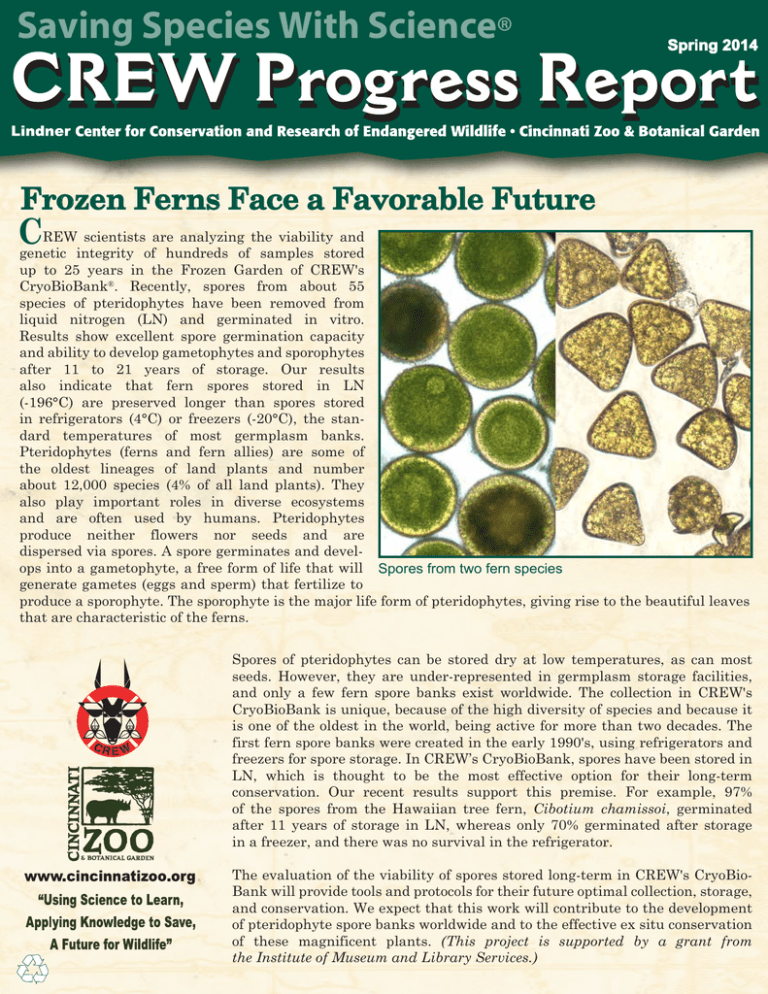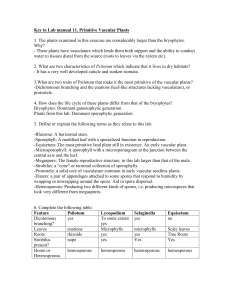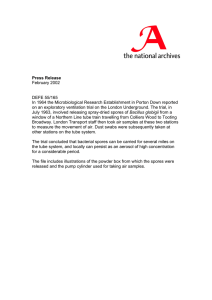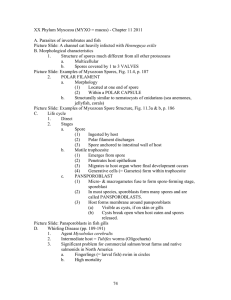Saving Species With Science C Frozen Ferns Face a Favorable Future ®
advertisement

Saving Species With Science® Spring 2014 Frozen Ferns Face a Favorable Future C REW scientists are analyzing the viability and genetic integrity of hundreds of samples stored up to 25 years in the Frozen Garden of CREW's CryoBioBank®. Recently, spores from about 55 species of pteridophytes have been removed from liquid nitrogen (LN) and germinated in vitro. Results show excellent spore germination capacity and ability to develop gametophytes and sporophytes after 11 to 21 years of storage. Our results also indicate that fern spores stored in LN (-196°C) are preserved longer than spores stored in refrigerators (4°C) or freezers (-20°C), the standard temperatures of most germplasm banks. Pteridophytes (ferns and fern allies) are some of the oldest lineages of land plants and number about 12,000 species (4% of all land plants). They also play important roles in diverse ecosystems and are often used by humans. Pteridophytes produce neither flowers nor seeds and are dispersed via spores. A spore germinates and develops into a gametophyte, a free form of life that will Spores from two fern species generate gametes (eggs and sperm) that fertilize to produce a sporophyte. The sporophyte is the major life form of pteridophytes, giving rise to the beautiful leaves that are characteristic of the ferns. Spores of pteridophytes can be stored dry at low temperatures, as can most seeds. However, they are under-represented in germplasm storage facilities, and only a few fern spore banks exist worldwide. The collection in CREW's CryoBioBank is unique, because of the high diversity of species and because it is one of the oldest in the world, being active for more than two decades. The first fern spore banks were created in the early 1990's, using refrigerators and freezers for spore storage. In CREW’s CryoBioBank, spores have been stored in LN, which is thought to be the most effective option for their long-term conservation. Our recent results support this premise. For example, 97% of the spores from the Hawaiian tree fern, Cibotium chamissoi, germinated after 11 years of storage in LN, whereas only 70% germinated after storage in a freezer, and there was no survival in the refrigerator. The evaluation of the viability of spores stored long-term in CREW's CryoBioBank will provide tools and protocols for their future optimal collection, storage, and conservation. We expect that this work will contribute to the development of pteridophyte spore banks worldwide and to the effective ex situ conservation of these magnificent plants. (This project is supported by a grant from the Institute of Museum and Library Services.) Successful Fixed Time Artificial Insemination in the Fishing Cat CREW continues to make progress in improving the suc- cess of artificial insemination (AI) for propagating endangered cats. In recent research, we incorporated treatment with oral progesterone (Regumate) into our AI protocol for domestic cats to down-regulate ovarian function prior to ovarian stimulation. This approach allows us to control ovarian activity more precisely and conduct AI procedures on a fixed time schedule. Our first attempt using this method in exotic felids involved our fishing cat (Ratana) who was incapable of breeding naturally after losing a front leg due to injury. Ratana was fed a small amount of oral progesterone daily for one month to suppress her ovarian activity and then treated with gonadotropins to induce follicular growth and ovulation. Laparoscopic AI of both oviducts with freshly collected sperm from our resident male (Gorton) resulted in conception and the birth of a male fishing cat kitten after a 69 day gestation. This kitten was the first non-domestic cat born following the use of oral progesterone for fixed time AI, and represents the fifth cat species (fishing cat, ocelot, Pallas’ cat, tiger, domestic cat) that we have produced with oviductal AI. This new approach could greatly advance our capacity to use AI for the genetic management of endangered felid species. photo by Connie Lemperle The Beagle vs The Lab Last autumn, Elvis (the Beagle) smelled fecal samples collected from 17 female polar bears and made his predictions on which bears might be pregnant. Unfortunately, only one female in North America had cubs in the 2013 cubbing season, so his opportunities for positive diagnoses were limited. Regardless, Elvis’s reliability to predict which females would or would not have cubs was an impressive 91%. Concurrently, scientists at CREW are using laboratory analyses (the Lab) in an attempt to identify which chemical components of feces Elvis might recognize in pregnant samples. Preliminary data reveal that there is no single volatile chemical present in the pregnant samples that is absent in the non-pregnant samples, so it is likely that Elvis has figured out a scent signature associated with pregnancy, probably involving many compounds. Elvis lives at IronHeart High Performance Dogs (Kansas) where he receives maintenance training to keep his nose ready for the 2014 cubbing season. (This project is supported by funds raised from the annual Polar Bear Challenge to support CREW’s Polar Bear Conservation Project.)







